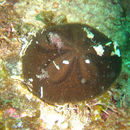mk
имиња во трошки


In Panama this species has been collected in the Caribbean from:
-Margarita Island, Fort Randolph, Limon Bay (USNM E 26631)
-Cayo Crawl, between Popa and Bastimentos Islands, Bocas Del Toro (USNM E 36661; depth 0 to 10 m)
-Pico Feo Island, San Blas (USNM E 18819, USNM E 18803; Centroid Latitude: 9.5500, Centroid Longitude: -78.9833)
-Corgetupo Island, San Blas (USNM E 26629)
Mortensen, T. (1948). A monograph of the Echinoidea 4(2). Clypeasteroida. Copenhagen. 471 pp., 258 figures, 72 pls; pages: 40-44.
Diplothecanthus rosaceus (Linnaeus, 1758) (transferred to Clypeaster)
Echinanthus rosaceus (Linnaeus, 1758) (transferred to Clypeaster)
Echinus rosaceus Linnaeus, 1758 (transferred to Clypeaster)
Clypeaster rosaceus, the fat sea biscuit,[2] is a species of sea urchin in the family Clypeasteridae. It occurs in shallow water in the western Atlantic Ocean and was first scientifically described in 1758 by Carl Linnaeus.
This is a very large sea biscuit with a strong inflated test, growing to a maximum length of around 200 mm (8 in). In shape it is ovate to slightly pentagonal, with the margin thicker at the anterior end. The petaloid area is broad, the anterior (front) petal being longer than the two posterior, paired petals, which are all of equal length; the area between the pores is wide and raised above the rest of the aboral (upper) surface. The oral (under) surface is fairly flat, with a deep depression around the mouth, and with deeply indented food grooves. The anus is on the oral surface near the posterior margin. The spines are short and coarse. When alive, this species is a dark brown colour, while the bare test is whitish.[3]
Aboral and internal views, by Ernst Haeckel in Kunstformen der Natur (1904)
Preserved test in the Natural History Museum (London).
The species is found in the western Atlantic Ocean. Its range extends from South Carolina to the West Indies, Barbados, Texas and Venezuela. It is found on soft sandy bottoms, particularly in seagrass meadows, from the littoral zone down to about 50 m (160 ft).[3]
C. rosaceus lives on the surface of sandy seabeds and is nocturnal. It feeds on fragments of dead plant material and algae particularly among seagrass plants. In the process of feeding it grinds up sand particles with its Aristotle's lantern mouthparts, and it has been estimated that it reduces 5.5 kg (12.1 lb) of coarse particles of sediment into fine particles in the course of a year. During the daytime it is inactive and buries itself or covers its test with fragments of shell and pieces of seagrass, holding these in place with its tube feet.[2][3]
In Panama, breeding takes place annually in the rainy season, with spawn being liberated into the sea. The eggs contain much yolk to sustain the developing larvae, which settle on the seabed and undergo metamorphosis after about six days.[2]
Clypeaster rosaceus, the fat sea biscuit, is a species of sea urchin in the family Clypeasteridae. It occurs in shallow water in the western Atlantic Ocean and was first scientifically described in 1758 by Carl Linnaeus.
Le dollar des sables à rosace (Clypeaster rosaceus) est une espèce d'oursin irrégulier, présent dans l'océan atlantique tropical ouest.
C'est un oursin irrégulier aplati et allongé, dont l'anus a migré vers la périphérie de la face orale (inférieure) du test (coquille), pour former un « arrière ». Il mesure jusqu'à 13 cm de long pour 4 cm d'épaisseur. Il est recouvert d'un dense tapis de fines radioles (piquants) de couleur rose-violacé, qui lui servent à progresser dans le sable. Les aires ambulacraires sont en forme de 5 gros pétales de deux rangées de pores, comme chez tous les Clypeasteroida. Les podia sont modifiés en branchies[1].
Clypeaster rosaceus (face aborale et vue supérieure des organes internes), dessiné par Ernst Haeckel dans les Formes artistiques de la nature (1904).
Spécimen naturalisé du Natural History Museum à Londres.
On trouve cet oursin à faible profondeur sur les fonds sableux des Caraïbes, notamment aux Antilles[1].
Cet oursin est un fouisseur : il filtre le sable pour se nourrir de matière organique.
Le dollar des sables à rosace (Clypeaster rosaceus) est une espèce d'oursin irrégulier, présent dans l'océan atlantique tropical ouest.
Clypeaster rosaceus is een zee-egel uit de familie Clypeasteridae.
De wetenschappelijke naam van de soort werd in 1758 gepubliceerd door Carl Linnaeus.[1]
Bronnen, noten en/of referentiesВид проживає на глибинах від 0 до 285 м. Поширений на узбережжі: від Південної Кароліни до західної Вест-Індії; Барбадосу, Техасу, Венесуели, Панами[2]. Розміри — 7 см.[3]
З галереї морських безхребетних в Музеї природознавства, Лондон